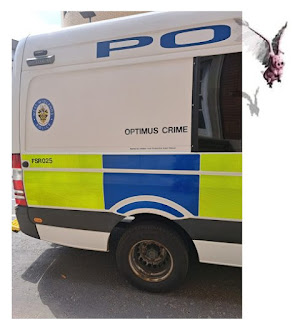Thought for the day :"I’m in a great place at the moment – maybe not physically, mentally or emotionally, but there is wine in this place"
Rain 6 : Dry 5
Nice visit from Chris and Vickie this afternoon and stayed for dinner but headed back home for the night.
Chris joined me in a walk of the dogs along the normal route ...
Meanwhile - Toby was on parade to greet Jim the Pipe, and get a few treats of course....
Meanwhile, seem to have puncture in my wheelbarrow - filled it with stones but couldn't get down the garden . Managed to do my 5 a day yesterday (well 4 but it was tiring!) But down to two bags of stones now ...
Have to find a new wheel I think - not sure it is worth trying to repair. Will check the prices - and whether I have replaced before.
In other news:
On 11th January 1970, the last trolleybus ran in Cardiff, the last such system in Wales. A trolleybus was an electric bus that was run by the electricity supplied from overhead wires, through spring-loaded trolley poles. It differed from a tram in that it didn't need tracks.
1902 - The Corporation of Cardiff introduced electric powered trams when it took over the private Cardiff Tramway Company which had been supplying a service of horse pulled trams and buses since 1870.
Private operators had been running horse buses since at least 1845.
1914 - The first trolleybuses in Wales come into operation in Aberdare. They were initially however beset with problems as they suffered damage from the poor road surface and the electric collectors (nicknamed the 'monkey') were prone to drop off the wires and land in the street.
1942 - The first trolleybuses were introduced in Cardiff. In terms of comfort and speed, the trolleybus was popular with passengers, as the lack of vibration and the quietness made them very comfortable. However, their quietness earned them the nickname "the silent death" as pedestrians quite often could not hear them coming. Cardiff was unusual in that it had single-deck trolleybuses as well as double-deckers, due to several low bridges in the docks area.
1962 - Motor buses began to replace the trolleybuses. Motor buses were operated since the early part of the 20th century, but early journeys would have been uncomfortable as pneumatic tyres were not fitted until 1924.
1970 (11th January) - The last trolleybus ran in Cardiff.
Interestingly for me, Llanelli had its own trolley bus system..
The Llanelly trolleybus system was unusual, in that it was one of the few privately owned systems, as it was part of the Llanelli & District Electric Supply Company, who also owned the North Dock power station. The trolleybuses therefore became the responsibility of the fledgling South Wales Electricity Board.
Llanelly and District Electric Tramways operated a standard gauge tramway service in Llanelli, Wales, between 1908 and 1933.[1] It was the successor to a 3 ft (914 mm) gauge horse tramway, which ran from 1882 until 1908. A complex series of negotiations took place in the early 1900s, resulting in the horse tramway being converted to an electric tramway. Standard gauge horse trams were run initially, until the company completed North Dock power station, which supplied electricity to the tramway. Two of the employees who worked on the construction went on to found Balfour Beatty.
In 1929 the company announced that the trams would be replaced by trolleybuses, and the changeover was completed by 1933. The trolleybus routes were extended a little from the tramway routes. Because the owning company also owned the power station, the system was nationalised in 1947 as a result of the Electricity Act 1947, becoming the responsibility of the South Wales Electricity Board. This period corresponded with a downturn in profitability, and the system was sold to the South Wales Transport Company, with a view to closing it down. The sale took place in March 1952, and the system was closed in November 1952.
Cheers !











No comments:
Post a Comment